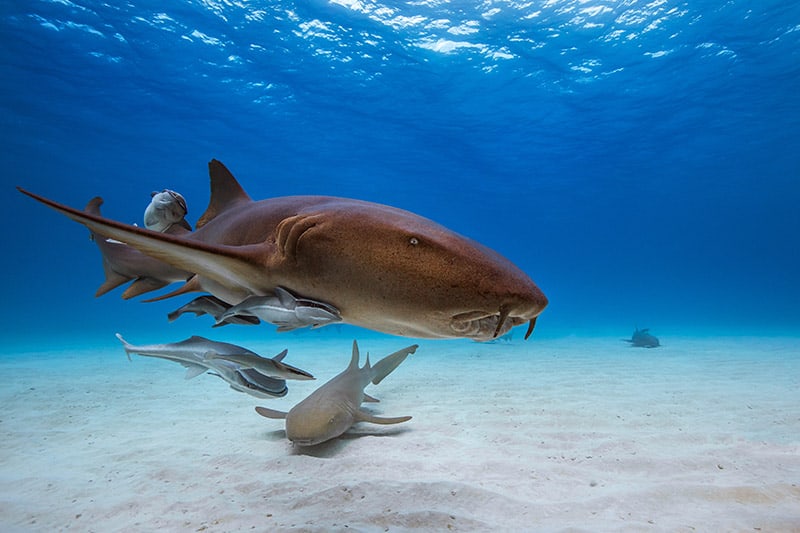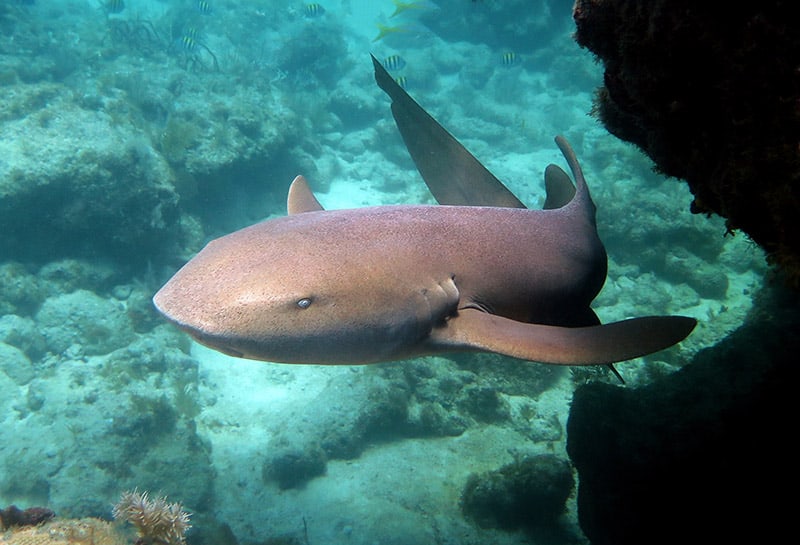The Nurse Shark is one of the most available sharks and is easy to keep. But despite it’s popularity, the Nurse Shark has one major drawback as an addition to your aquarium. it can grow very large, up to approximately 14 ft. (430 cm)! We are talking about a fish that will need a lot of space! It must be housed in a huge aquarium, up to 1400 gallons!
The Nurse Shark belongs to the family Ginglymostomatidae of which there are two genera with two species each. Members of this family have two relatively close-set dorsal fins of about equal size on the posterior half of the body. They also have a pair of barbels below the snout, and a groove between each nasal opening and the corner of the mouth. The Nurse Shark are considered harmless unless provoked.
- For more Information on keeping marine fish see: Guide to a Happy, Healthy Marine Aquarium
Nurse Shark, Ginglymostoma cirratum
A Nurse Shark will grow to 14 feet long, so unless you have a 30,000 gallon tank or more, this may be a fish to pass on as a pet! There are many other sharks that only reach 2 to 3 feet that only need about 200 to 300 gallons, which is much more reasonable! Nurse sharks are very cool to encounter in the wild, being very docile and gentle giants.
Scientific Classification
| Kingdom: | Animalia |
| Phylum: | Actiniform |
| Class: | Elasmobranchii |
| Order: | Orectolobiformes |
| Family: | Ginglymostomatidae |
| Genus: | Ginglymostoma |
| Species: | cirratum |

Maintenance difficulty
The Nurse Shark is easy to keep but may get too large for most aquariums. They can reach 430 cm. (approx. 14 ft.). The minimum recommended size aquarium is 5000 liters (1400 gallons). They are usually sold as smaller juveniles at about 40-50 cm.
Maintenance
Keep in a large aquarium and feed regularly several times a week. They cruise the bottom in search of food with their barbels close to the bottom. A sandy bottom is preferred. In the wild their diet includes fishes, crabs, prawns, lobsters, other crustaceans and cephalopods.
Habitat: Natural geographic location
Nurse Shark are found in the Atlantic and Eastern Pacific. They occur on coral and rocky reefs, usually close to shore.
Foods
Feed all kinds of large meaty foods like small pieces of fish, squid, shrimp, and live goldfish.
Social Behaviors

Sexual differences
The medial edges of the male’s pelvic fins are modified to form claspers. The claspers are tubelike organs designed to deliver sperm into the female’s reproductive tract. As the males grow older the claspers become more pronounced. The females do not have these.
Recommended light levels
Breeding/Reproduction
This species is oviviparous, meaning the eggs are fertilized internally. The young are nourished mainly by yolk while in the uterus. Litters of 20-30 young have been reported.
Temperature
Temperature should be around 26 degrees C.
Length/Diameter of fish
Nurse Shark adults can grow to 430cm (14 ft.) but are usually smaller in aquariums.

Minimum Tank Length/Size
A minimum 150 gallon aquarium is recommended for juveniles but they will outgrow this!
Water Movement: Weak, Moderate, Strong
Water Region: Top, Middle, Bottom
They spend most of their time on the bottom..
Availability
This fish is rarely available and is expensive.
- Beginner Fish – Saltwater fish for beginners
- Community Fish – Peaceful Saltwater fish
- Hardy Fish – Hardy Saltwater fish
Featured Image Credit: Daryl Duda, Shutterstock
